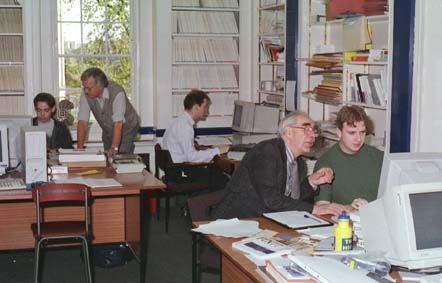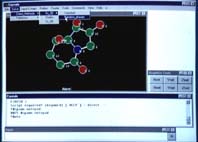chem cryst
X-ray Crystallography
University of Oxford
+ Crystals
Contact
Lectures
+ Links
+ Gallery
CSD installation
Chemistry Dept
Division
University of Oxford
chem cryst news
Research & Facilities
 David Watkin oversees a group
currently consisting of two emeritus professors,
two post doctoral researchers, two D.Phils, and two
Part II students.
David Watkin oversees a group
currently consisting of two emeritus professors,
two post doctoral researchers, two D.Phils, and two
Part II students.
Members of other groups are encouraged to do their
own structural analyses, and space, computers and expert advice are available
for them in the laboratory. There are currently eighteen
crystallographer/chemists authorised to use the X-ray diffraction equipment.
A particular virtue of the Oxford environment is that students have hands-on access to all equipment. At the beginning of the year, Part II students are given a refresher course in X-ray crystllography, and then shown in detail how to use the equipment. Each student has their own modern PC for processing the diffraction data, accessing databases, performing statistical tests and for developing crystallographic software.
New Software
The Chemical Crystallography Laboratory in Oxford and Judith Howard's laboratory
in Durham have been awarded a substantial EPSRC grant to develop a totally
new program system for small molecule crystallography. This will be written in
modern programming languages, and aim to incorporate the best features from
CRYSTALS
GSAS
Jana
PLATON
SHELXL
XD
XP
plus organisational features found in high-level systems such as:
MaXus
System-S
WinGX
In addition to providing excellent crystallographic facilities, it is intended that the code will be well structures and well documented so that other groups can eventually contribute codes, leading to a system which is open and diverse.
As with X-Ray and later with Xtal, we aim to offer users a rich wealth of tools and alternative procedures so that their research is not circumscribed by prescriptive restrictions.
CRYSTALS Development
 Because of our involvement in the major project to develop new software,
the development of CRYSTALS is now being cut back to maintenance and
minor enhancements in response to users requests.
Our software,
CRYSTALS is used world wide
and has been presented and demonstrated at many meetings and workshops.
The long-term aims of the work are to encode chemical and crystallographic
knowledge into an autonomous program for routine use by chemists, and to
provide novel software tools for professional crystallographers.
A computer program should be regarded just like any other laboratory
apparatus. It may be a quick solution to a one off problem, or it may
be more carefully designed so as to have a long and useful life. The role
of Part II students has been to write pilot programs to help evaluate
ideas. Those ideas shown to be sound and useful are then incorporated into
the distributed programs by D.Phils, Post Docs or permanant members of
the laboratory.
Because of our involvement in the major project to develop new software,
the development of CRYSTALS is now being cut back to maintenance and
minor enhancements in response to users requests.
Our software,
CRYSTALS is used world wide
and has been presented and demonstrated at many meetings and workshops.
The long-term aims of the work are to encode chemical and crystallographic
knowledge into an autonomous program for routine use by chemists, and to
provide novel software tools for professional crystallographers.
A computer program should be regarded just like any other laboratory
apparatus. It may be a quick solution to a one off problem, or it may
be more carefully designed so as to have a long and useful life. The role
of Part II students has been to write pilot programs to help evaluate
ideas. Those ideas shown to be sound and useful are then incorporated into
the distributed programs by D.Phils, Post Docs or permanant members of
the laboratory.
[Research | David Watkin | Keith Prout | X-ray diffraction suite | Z prime | Twins | Mogul ]

